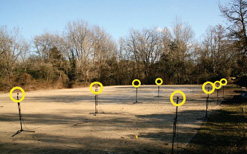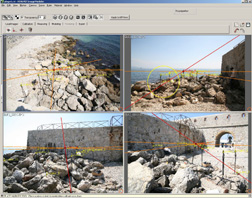
3D-Audio Matting, Post-Editing and Re-rendering from Field Recordings
E. Gallo1,2, N. Tsingos1 and G. Lemaitre1
1REVES-INRIA and 2CSTB

Left: We use multiple arbitrarily positioned microphones (circled in yellow) to simultaneously record real-life auditory environments. Middle: We analyze the recordings to extract the positions of various sound components through time. Right: This high-level representation allows for post-editing and re-rendering the acquired soundscape within generic 3D audio rendering architectures.
We present a novel approach to real-time spatial rendering of realistic auditory
environments and sound sources recorded live, in the field.
Using a set of standard microphones distributed throughout a real-world
environment we record the sound-field simultaneously from several locations.
After spatial calibration, we segment from this set of recordings a number of
auditory components, together with their location. We compare existing
time-delay of arrival estimations techniques between pairs of widely-spaced
microphones and introduce a novel efficient hierarchical localization
algorithm. Using the high-level representation thus obtained, we can edit and
re-render the acquired auditory scene over a variety of listening setups. In
particular, we can move or alter the different sound sources and arbitrarily
choose the listening position. We can also composite elements of different
scenes together in a spatially consistent way. Our approach provides efficient
rendering of complex soundscapes which would be challenging to model using
discrete point sources and traditional virtual acoustics techniques. We
demonstrate a wide range of possible applications for games, virtual and
augmented reality and audio-visual post-production.
Download a video describing our technique and early results here ! (divx format)
(NEW)
Video comparing original monophonic recordings and our approach (divx
format)
(full FIR filtering using
head-related transfer function (HRTF) data from the LISTEN HRTF database)
Additional example results
Explicit background/foreground separation and resulting re-renderings
Example 1: Outdoor scene with two moving speakers

Example 2: Seashore scene

(click on picture for a larger view of the image-based calibration using
ImageModeler © RealViz)
Comparison of our warping algorithm (delay/distance compensation based on
estimated source positions)
compared to direct blending between recordings
Example 1: Synthetic case with telephone + chopper mixture
Example 2: Indoor recording with two speakers
More recent and improved results in an indoor environment
Compositing of two auditory scenes (car + moving speakers).

Click here for the Divx movie file (12 subbands + hardware HRTF rendering using DirectSound and SoundBlaster Audigy)
Related publications
This work is submitted for publication
Acknowledgments
This research was made possible by a grant from the
région PACA and the RNTL Project OPERA.